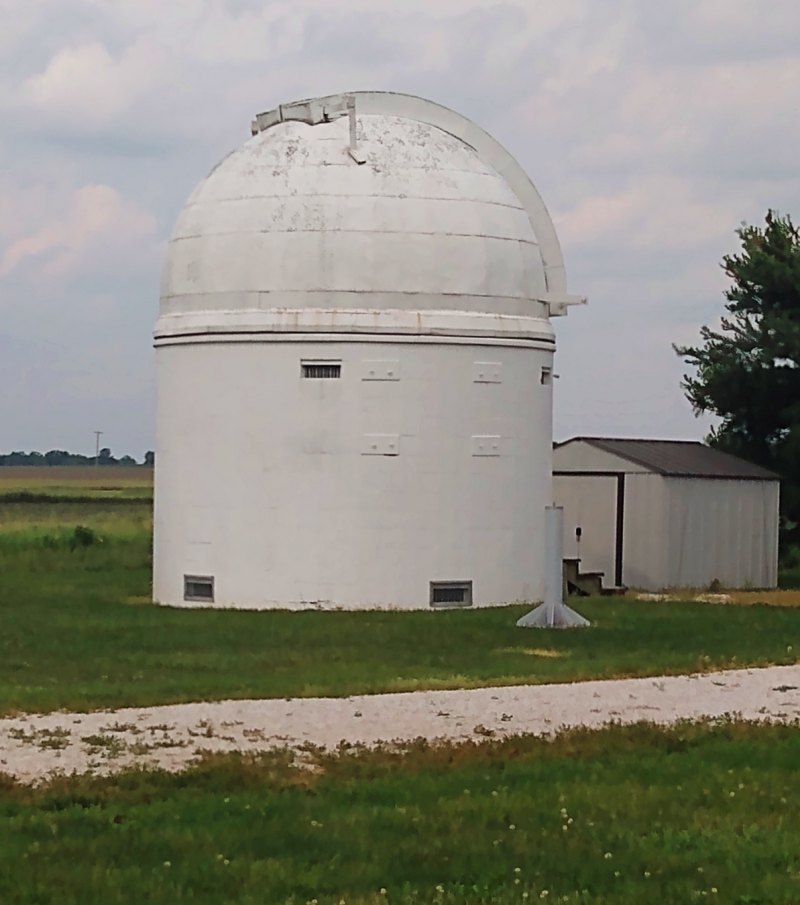Driving down County Road 700 this past Saturday night, I saw no light whatsoever in the fields as a domed structure, the observatory, came into view. I was worried that the event — a monthly Skywatch run by the Champaign-Urbana Astronomical Society — had been cancelled (and I would have nothing to write about). Their website did say weather permitting, and I saw more clouds at twilight than I would have liked. Fortunately, as I got within a half mile of the dome, the small amount of light from the crescent moon revealed a few parked cars. It was on.

Photo by Michael O’Boyle.
Stepping out of my car, I saw a small group — a family, I presumed — near a reflector telescope on the lawn in front of the second, functional observatory. I would learn that larger telescopes housed inside were closed due to the weather. Only the one I saw outside and a smaller one inside were operating that night. However, people had shown up and the Society was going to put on a show. It was dark enough that I could not always tell who was speaking. I tried to make out as much of their conversations as I could while I looked up.
First, I heard an adult responding to a boy’s question, “You know, Pluto is not perfectly spherical, so —”
“Look, there are four stars of the Big Dipper!” another adult exclaimed.
I bent my head back and gazed at the row of bright dots visible through a crack in the clouds.
The next thing I heard was the first adult asking, “How many trips around the sun have you taken?”
“One.”
A third adult asked, “How many birthdays have you had?”
“Six.”
The first adult said, “Well, then you’ve been around the sun six times.”
I started to hear the boy retort that he had heard that joke before when someone different excitedly announced that part of the moon was in focus on the telescope. He invited me to look at the image made hazy by the partial cloud cover and said “Welcome to Illinois” as an apology. Still, it was quite a sight, and it inspired something I had not felt in a very long time. I was quite young when I last looked through an eyepiece and examined lunar craters, and the experience brought the same wonder I felt then. I had forgotten the excitement of observing the details of something so large and distant with my own eyes.
After staring for a few moments, I stood from my squat, and the telescope’s operator directed me indoors where the other telescope was set up. Passing the same group again, I now heard one of the adults explaining that, when the moon is full, it is directly overhead at midnight.
One of the younger listeners then observed, “It’s night now.”
Once inside and out of earshot of the outside crowd, I experienced the novelty of trying to mount my smartphone near a telescopic eyepiece in the dark only to have the operator do it for me. I could then take pictures of the moon’s surface (one of which is the top photo) once I tapped my screen to bring it into focus. While fumbling to remove my phone, I tried to strike up a conversation with the operator by asking how he became involved with CUAS. Turns out he was the founder! He told the story of how it began as a series of workshops on how to observe Hailey’s Comet run in 1986, but there was enough interest to form a permanent club. He also talked about the larger telescopes in the structure, including two large ones that were recently donated.
While describing some of the society’s activities, he was frequently interrupted by loud banging. Another society member was on a ladder behind him nailing something on the wall while complaining that the wind had shifted something in the roll-off-roll-on roof. He eventually climbed down, and we also conversed about the society’s activities. They meet on the second Thursday of the month in the Staerkel Planetarium of Parkland College. In addition to the Skywatch open house, they have “members-only” observing events which are sometimes held in Meadowbrook Park. To boot, after six months as a dues-paying member, you get keys to the observatories.
Then, I let it slip that I have a physics background, and the hammer-wielding member proceeded to quiz me. We discussed the outdated theory that the sun is powered by the nuclear fusion of carbon mentioned in an Isaac Asimov novel (The Currents of Space, not one of his better ones in my opinion…) and the idea’s mention in a Sky & Telescope magazine article from the 1940s.
As I took note of some of the informational posters around the inside, the hammer-wielder came over and pointed to an image of a nebula constructed from radio wave observations; the Moon was shown as a small white dot in the bottom corner for comparison. He expounded on his marvel at the scale of such objects: that its true extent can only be appreciated when we consider a property our eyes cannot perceive. It is a familiar refrain, that the universe and objects within it are so vast they exceed human imagination, but he reminded me that it can be a source of wonder.
By the time I stepped outside again, the group had left, bringing the event to an effective conclusion. The weather and turnout made it difficult to have the full Skywatch experience, but I came away with a feeling of the simplest of joys: observing something interesting beyond daily experience, and sharing it with like-minded strangers. The next Skywatch is scheduled for July 2nd, so here’s hoping for clear skies!








